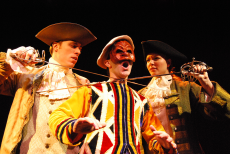
Email: EllaTournes@bexleygs.co.uk
Total Article : 45
About Me:Sixth form student currently studying English Literature, Drama and Theatre Studies, Classical Civilisation and History.

Act 1, Scene 1 is the scene that introduces and the plot, themes and characters of ‘A Servant to Two Masters’. The amorous relationship between Silvio and Clarice is established, as well as the status disparity between characters like Pantaloon and Dr Lombardi, and characters like Smelderina and Brighella. The themes of love, sex, food and money are all presented in this first scene in a classically ‘commedia’ way – through the use of stock characters and situations, with an emphasis on improvised comic business (‘lazzis’). However, despite aiming to create comedy, Goldoni puts more of an emphasis on psychological realism than ‘pure’ commedia, reforming the genre to accommodate the tastes of a more modern audience. If I were to direct Act 1, Scene 1 to create comedy for an audience, I would want to stick to the comedic tropes of commedia dell’arte, whilst still maintaining Goldoni’s intention of making the characters more multi-dimensional.
One of the most integral relationships in the play, that drives the plot and gives the most scope for Goldoni’s desire for psychological realism, is the relationship between Clarice and Silvio. I think that upon first impression, the audience should understand the exaggerated, desperate nature of their love, in order to understand their heartbreak that follows later. I would create comedy in the moment after Silvio says ‘and mine to be your husband’, by inserting a lazzi into the scene. In my opinion the lazzi should be long enough to create comedy, but not too long as to stunt the ‘setting up’ of the play. The lazzi would involve Clarice overwhelming herself with emotion – she would pull her brows exaggeratedly inward and upward, widening her eyes, clenching her firsts and pulling them into her chest in a tense, exaggerated fashion, and she would seem to shake a little, before gasping loudly, throwing the back of her hand against her forehead, opening her mouth in a shocked fashion, shutting her eyes and twirling away from Silvio in a quick, indirect manner. This be followed by Silvio copying her movement and facial expression (showing a likeness between them) and twirling away, to stand behind Pantaloon. Clarice would then open her eyes and not see Silvio where he had been standing before – this would cause her to furrow her brow, and desperately look for him from left to right, sharply snapping her head from side to side, saying his name in a high-pitched, animated, desperate tone. Silvio would then call her – ‘I’m here, Clarice, my love’, then Clarice would run to him, and the lovers would reunite by clasping eachothers hands through Pantaloon’s arm. The ridiculousness of the lovers' stupidity in not being able to find each other in such close proximity, and the frustration of Pantaloon in being caught in between their display of affection (shown by a frown and a sharp tut), would create comedy for the audience and would establish Silvio and Clarice’s relationship.
On the Pantaloon’s line ‘Steady on there, just make sure there’s something soft I can dip my bread in’, I would aim to create comedy and express one of the play’s major themes – sex. When delivering this line, I would have Pantaloon stand in his stock physicality, with an emphasis on his money belt – an emphasis that also draws attention to his groin. I would make the phrase ‘dip my bread in’ euphemistic, having Pantaloon wink at the audience and squat down, emphasising his groin area by rubbing his hands up and down his thighs in a suggestive way. I would also have him point his hands very obviously toward his crotch, and say the line in a sustained, pointed manner, creating comedy through the absolute lack of subtlety. I would also create comedy by making Pantaloon seem lecherous – I would have him lisp the word ‘soft’, and rub his legs for an uncomfortably long time. I would also create comedy by emphasising Pantaloon’s age – a running gag I would utilise throughout the play. I would have Pantaloon get stuck in his suggestive squat, and reach for his back with a pained facial expression, groaning in a loud and exaggerated way.
On Smeraldina’s line, ‘I know’, when Pantaloon informs her that there was a knock at the door, I would create comedy by inverting her status. Smeraldina should technically be lower-status than Pantaloon as servant, but at this moment her intelligence over his gives her higher status. I would have her stand tall and upright, creating a tangible difference in height between her and Pantaloon. I would have her look at him as if he were an idiot, with furrowed brow, a slightly cocked head and a hand on her hip. I would then have her put her hands on her knees and crouch slightly in a sustained, direct manner, as if talking to a child. I would then have her raise her eyebrows slightly, smirk a little, and nod exaggeratedly on the line ‘I know’ (which I would have her say in an exaggeratedly slow way, with a very condescending tone). This would create comedy for the audience, as Pantaloon is being mocked.
By directing the scene this way, I feel I would’ve established the play’s distinctive comedic style, and achieved my intention of making the audience laugh, whilst still maintaining the intentions of Goldoni. The characters relationships would’ve been made clear through a farcical style of acting – giving the audience a better understanding of the play, and setting them up for a hilarious and entertaining night at the theatre.

0 Comment:
Be the first one to comment on this article.